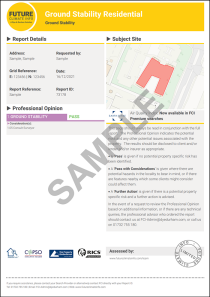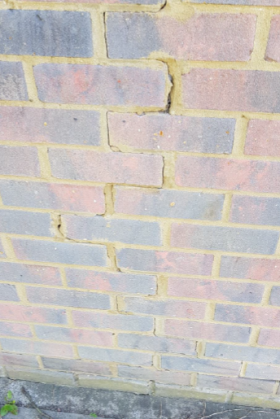What is Subsidence?
Subsidence are the effects of the movement of a property's foundations. Shallow foundations, clay sub-soil, tree roots and dry weather are a combination that can make subsidence a real danger for properties. Even the masonry used can compound the issue; if a property is built with calcium silicate bricks (see below), for example, the builder has to ensure that the mortar used thermally expands in a similar way to the bricks if cracking - and structural weakness - is to be avoided.
According to Which? Around 70% of subsidence cases are due to tree roots. The crack you found may indeed simply be settlement and not subsidence. But If you see a crack the width of a 50p coin or more, you must get professional support from a structural engineer to 100% with an inspection of your foundations.
If during a mortgage valuation (click to read an example mortgage valuation survey) or a RICS survey subsidence is suspected then you must instruct a Structural Engineer to inspect the property and confirm what action is required to be taken. This is VERY important as most mortgage lenders will not lend you money if your property has subsidence.
We local RICS surveyors and structural engineers are trained in handling subsidence inspections. Call us on 0333 344 3234 (local call charges apply) to get a competitive quote and find out our availability.
There is structural movement. You now need to get a structural engineer or chartered building surveyor to make a detailed investigation, providing you with a full report identifying the cause, together with the costs of the work necessary to ensure future stability. I cannot give a valuation until I have seen the report."
Want help now? Call us on 0333 344 3234 (local call charges apply)
What is subsidence?
Subsidence is the lowering and shrinking of the ground under a house, which causes the property’s foundations to move, which causes minor subsidence in the first instance. As these foundations shift further, it produces movement in the upper parts of the property - this is when cracks can appear in walls and ceilings.
The ground or soil can move because of the removal of moisture, dry weather conditions or roots penetrating. Properties built before 1965 had shallow foundations and so are affected more by this ground movement.
There was a recent case where subsidence caused huge damage in to a property in St Albans - you can read more about this here - Subsidence in St Albans.
What causes subsidence?
The following are the main causes of subsidence.
- Trees Close to Property – When trees grow near a property, their roots can both draw water from the soil making it loose and they can grow in and around the foundations.
- Mining Area – If the property is built in a mining area, the probability that the ground under the foundations will shift or be more at risk of shifting due to mining works will be much greater.
- Clay Sub-Soils – In dry weather, water is removed from the clay soil, causing it to shrink and the foundations to destabilise. Clay soil is particularly bad for this as it normally holds a lot of water and so the removal of water will have more of an effect than other soil types
- Water Leaking – As much as the removal of water from the soil around the foundations can cause subsidence, water leaking in excess can also cause a problem. Water can wash away soil around the foundations and this is a particular problem when the ground is made up of sand, gravel or chalky soil.
What do subsidence cracks look like?
The first signs of subsidence are growing cracks. To test to see if a crack is getting wider you should stick a pin in it (coin, match stick, anything small enough to fit cosily in the crack). Leave the object in the crack and then keep an eye on it over the next few months. If the object continues to fall out as the gap gets wider you should call a Structural Engineer Immediately to come inspect your property.Not all cracks are caused by subsidence. Sometimes they can be a sign of spalled bricks, which we still recommend you treat, as they can become more serious.
What are the signs of subsidence?
- New Cracks appearing - Expansion of existing cracks - wider than 3mm (width of a 50p coin) in plasterwork and brickwork, particularly after a period of dry weather.
- Sticking doors - If the door frames move the doors won’t close properly.
- Wall Paper Ripples - When interior walls warp and move the wallpaper often lifts away
- A hairline crack is under 3mm - Cracks in plaster is very common, especially in new build properties. For it to be a crack that causes concern it would have to be wider than 3mm.
How to check for subsidence
- 1
Get a Subsidence Report for £45 INC VAT
A subsidence report will identify what type of soil your property is built on and if the area is at risk of subsidence. The subsidence report does not guarantee if you have subsidence, only if the soil your property is built on has a higher risk to cause subsidence.
If you're buying a property in Cheshire, you will be required to get a Cheshire Salt Search, to check if you're at risk because of brine mining subsidence and to highlight if you're eligible for compensation.
You would be advised to get this subsidence report if:
- You have no real concerns about subsidence; and/or
- You want to know whether the soil type under your property has a high or low risk of subsidence.
You would not be advised to this subsidence report if:
- You have already been advised by a qualified person that there is suspicion of subsidence at the property;
- You have cracks that are expanding; and/or
- You have a crack that is 3mm wide or larger
In these three cases above, you would be advised to have a structural engineer assess the situation, skip to step 3, below.
Order a subsidence search and put your mind at ease.
- Check for subsidence, landslide risks, and geo, mining and other hazards in the surrounding area.
- Find any damage claims for subsidence on your property and the surrounding area.
- Report delivered within 2 working hours*.
- Fixed fee of £45 INC VAT.

- 2
Get a RICS Survey from £500 to £1,000+
Either a HomeBuyer Report or a Building Survey will highlight if the surveyor suspects that your property has subsidence. They will also identify other key factors within their report, such as infestations, damp, asbestos and property defects. This is a good starting point for every home purchase and will provide a reliable professional opinion on whether subsidence may be present, as well as whether the third option (inspection by a structural engineer) is worth pursuing.
You can order a RICS survey from us today, and we have nationwide coverage with competitive prices. Call 0333 344 3234 to get a free quote.
- 3
Get a Structural Engineer
There are two assessments that a Structural Engineer could take, and which you choose depends on what you know about the potential subsidence you have flagged.
Non-Intrusive Subsidence Inspection from £600 upwards
The structural engineer attends the property and conducts a non-intrusive assessment of the property, providing an opinion on whether there are any signs/suspicions of subsidence.
You would be advised to get a non-intrusive survey if:
- You have not yet been advised by a qualified person that there is subsidence at the property
- You have 'hair line' cracks; and/or
- You have a crack that is under 3mm wide.
You would not be advised to get a non-intrusive survey if:
- You have already been advised by a qualified person that there is confirmed subsidence, or suspicion of subsidence at the property
- You have cracks that are expanding; and/or
- You have a crack that is 3mm wide or larger
Intrusive Subsidence Inspection from £600 upwards
You would go straight for having an intrusive subsidence inspection if a mortgage lender surveyor, RICS surveyor or any other qualified surveyor has flagged that the property has signs of subsidence. During this inspection, the structural engineer will visit the property and conduct an intrusive assessment with a builder, digging down to inspect the footings of the property's foundations. Their aim is to find where the subsidence is, what is causing it and what will need to be done to stabilise the foundations (for example, underpinning).
What are the costs of underpinning?
You can generally fix a subsidence problem: roughly only around 10% of subsidence-affected properties require underpinning. Underpinning can cost between £5,000 and £80,000, depending on the property's condition.
Alternatives to underpinning include Jet Grouting, where void areas are filled or even chemicals injected which turn the soil into solid aggregate.
You can also get supporting systems using piers, piles and jacks but all these remedies depend on a property's location and the subsidence's severity.
How can calcium silicate bricks add to issues if mortar used doesn't 'match' them?

Sometimes, calcium silicate bricks are used as the construction material for house building.
If builders choose to use these bricks, it's particularly important that they plan for the fact that these types of bricks have 1.5 times the thermal expansion of clay bricks.
This planning, in practice, means that constructors have to build additional slip planes, movement joists, and weaker mortar to account for the greater thermal expansion.
If these extra features are absent, where the mortar is stronger than the brick units, as the bricks expand with rising temperatures, there is an increasing risk of cracking and damage to the work (see the picture to the right for a 'real life' example).
As cracking occurs and increases, there is potential for water ingress, causing greater problems and involving greater expense to rectify. Any filling of existing cracks and repointing would only be a temporary fix.
Crack stitching helps; however, if you find yourself in this situation, you are advised to obtain a report from an experienced brick contractor to find out what work would be required for a comprehensive remedy, including introducing the necessary movement joints.
Andrew started his career in 2000 working within conveyancing solicitor firms and grew hands-on knowledge of a wide variety of conveyancing challenges and solutions. After helping in excess of 50,000 clients in his career, he uses all this experience within his article writing for SAM, mainstream media and his self published book How to Buy a House Without Killing Anyone.
Caragh is an excellent writer and copy editor of books, news articles and editorials. She has written extensively for SAM for a variety of conveyancing, survey, property law and mortgage-related articles.









